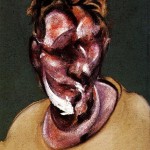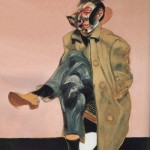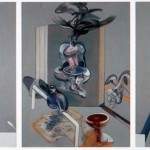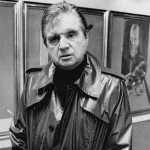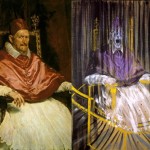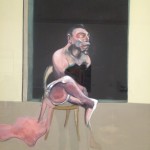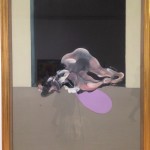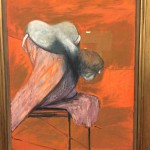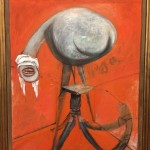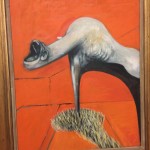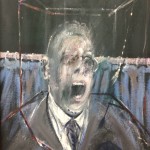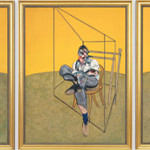“Since the death of Picasso, Francis Bacon has more than any other painter provided the age with an image, in Ezra Pound’s phrase, of its accelerated grimace. The key to his work is its ambition. He has taken on the great masters of the past without their mythological resources or their requirement to record events. At the same time he has turned his back on the abstract artist’s indulgence in decorative introspection: the painting whose principal subject is itself and the fact that someone painted it.” (Grey Gowrie )
Ask someone why they like a particular artist and they may draw attention to one favourite work, or maybe a common theme. You may enjoy Monet‘s water lilies or Degas‘ ballet dancers for their aesthetic qualities. You may look deeper and find a different level of appreciation in the work of Manet or Munch or Miro, among many others. But you would never admire the works of Francis Bacon for being soothing on the eye.
Bacon imbued his art with a raw, visceral savagery few could equal, such that it triggers parts of the psyche most artists never reach. That is the fascination for me – the hidden terrors just under the surface, the fears lurking in the subconscious.
There is for me a personal association here too: the day my marriage ended I went to see the Bacon retrospective at the Tate Modern. The screaming popes summed up my mood to perfection. Certainly I felt Bacon had tapped into places within my own psyche and committed to canvas the innermost parts of my mind, the ones I was otherwise keeping to myself. In an artist of any medium that is creative genius, in my humble opinion.
My initial attraction was to the 45 studies after Velázquez’s Portrait of Pope Innocent X. Of itself, the Velázquez painting is curious – the quizzical expression on the pope’s face and the paper in his hand inviting speculation from the viewer of what was on his mind. The most famous of Bacon’s studies has the pope screaming through a hail of warped vertical light, as if he is being slowly dissolved. Where in the Velázquez version the pope’s arms are draped in a languid fashion over the arms of his chair with an enigmatic expression perhaps looking grimly at someone beyond the artist, Bacon’s Innocent grips the chair in abject terror.
The subjects of Bacon’s paintings are frequently contained within a framework, as if caged to protect us; some of the frames are almost like a boxing ring. The characters are isolated, warped, beyond help or assistance within their cage. Their dark shapes lurk in the shadows, many twisted and tormented, suffering some tortured agony of their own devising. But the imagery is also sexual in some awful distorted way – a frightening vision of our own sexuality, just as Bacon tortured himself about his own sexuality.
In fact, even the artist himself in his extensive self-portraits seem to be melting away beneath his clothes, the face blurred as if moving while a photograph is being taken, somewhere else entirely. The blurring creates distance, as if the subject is distracted, mentally elsewhere – somewhere we can’t see. Something is hidden in the darkness, something pulling the strings, torturing the characters in such unspeakable ways.
Some are unmistakably human, distorted and dishevelled but others cruelly subhuman, belonging deep in the subconscious mind, like the strange figures at the base of a crucifixion (as opposed to the crucifixion.) These are grotesque and unidentifiable creatures, possibly the Eumenides, the three Greek furies who hound unpunished criminals, but viewed in context of the time when they were painted (1945) were possibly also a reaction to the terrors of the second world war. Death seems never very far away from these pictures, and in some there is the bloody stench of death, murder and butchery, including the use of sides of meat as subject matter.
The fact that so many of his paintings were in triptychs and series says something too: they tell a narrative, creating a 3D image of the subject by studying it from different angles, in subtly different moods, almost like a comic strip. In many ways they reflect but then subvert and distort the themes and methods of medieval religious art, much more than a passing nod but like all good art, the works of Bacon provoke thought and reaction through the use of parallels.
Watching an exhibition of works by Bacon is never a comfortable experience, but that is what the artist intended. Art, if it has any value, should surely challenge its audience and take them beyond their comfort zones, take us into the realms of our subconscious. In this respect Bacon can be compared to Freud for providing the medium to get inside the conscious mind.
PS. Enjoy this slideshow of Bacon’s works. The following is a biography on the same page:
Francis Bacon
- 1909–1992
- Nationality: British
Francis Bacon is one of the most famous 20th Century British painters. He is known for his raw graphic style and distorted images of people. Margaret Thatcher described him as “that man who paints those dreadful paintings”.
Bacon had a troubled childhood. He was forced to leave home at 16, and lived a rootless existence in London, Berlin and Paris. But in 1927, a Picasso exhibition in Paris inspired him to take up painting. By his 30s he was a successful artist.
Bacon turned traditional paintings of people inside out, with grotesquely distorted faces and twisted body parts. Some of his most famous artworks are inspired by old masters – such as Head VI, based on Portrait Of Pope Innocent X by the Spanish artist Diego Velazquez.
In the 1960s, Bacon fell in love with petty criminal George Dyer after he caught him breaking into his home. Dyer featured in many of Bacon’s works during this period, such as Study for Head of George Dyer. Dyer died of a drugs overdose but that did not stop Bacon obsessively painting him. Some of the paintings, such as Triptych, May-June 1973, show Dyer as he was found slumped dead in a hotel bathroom.




